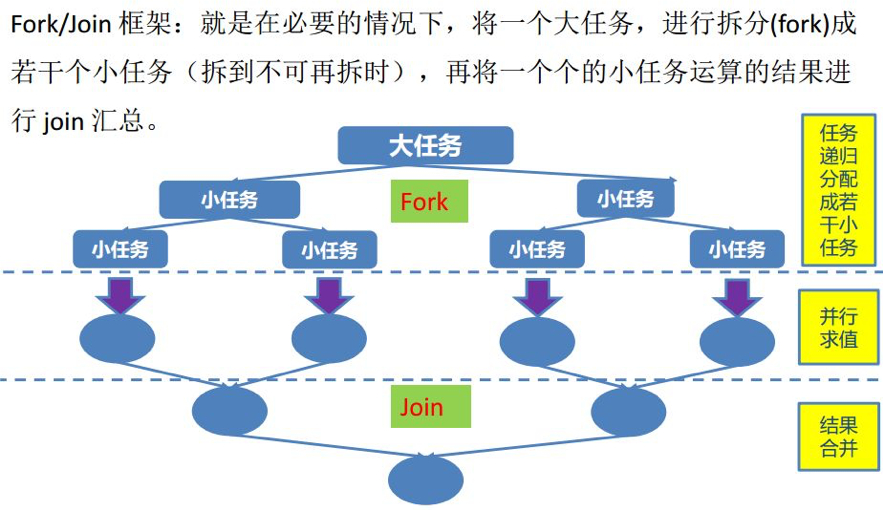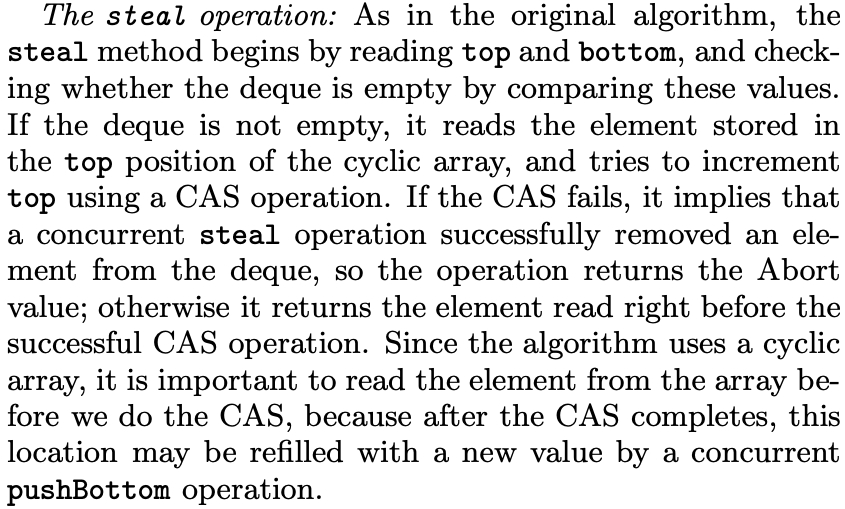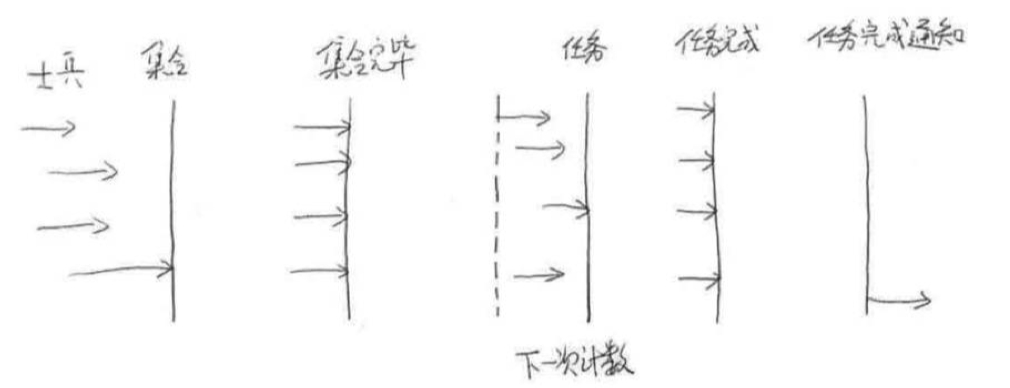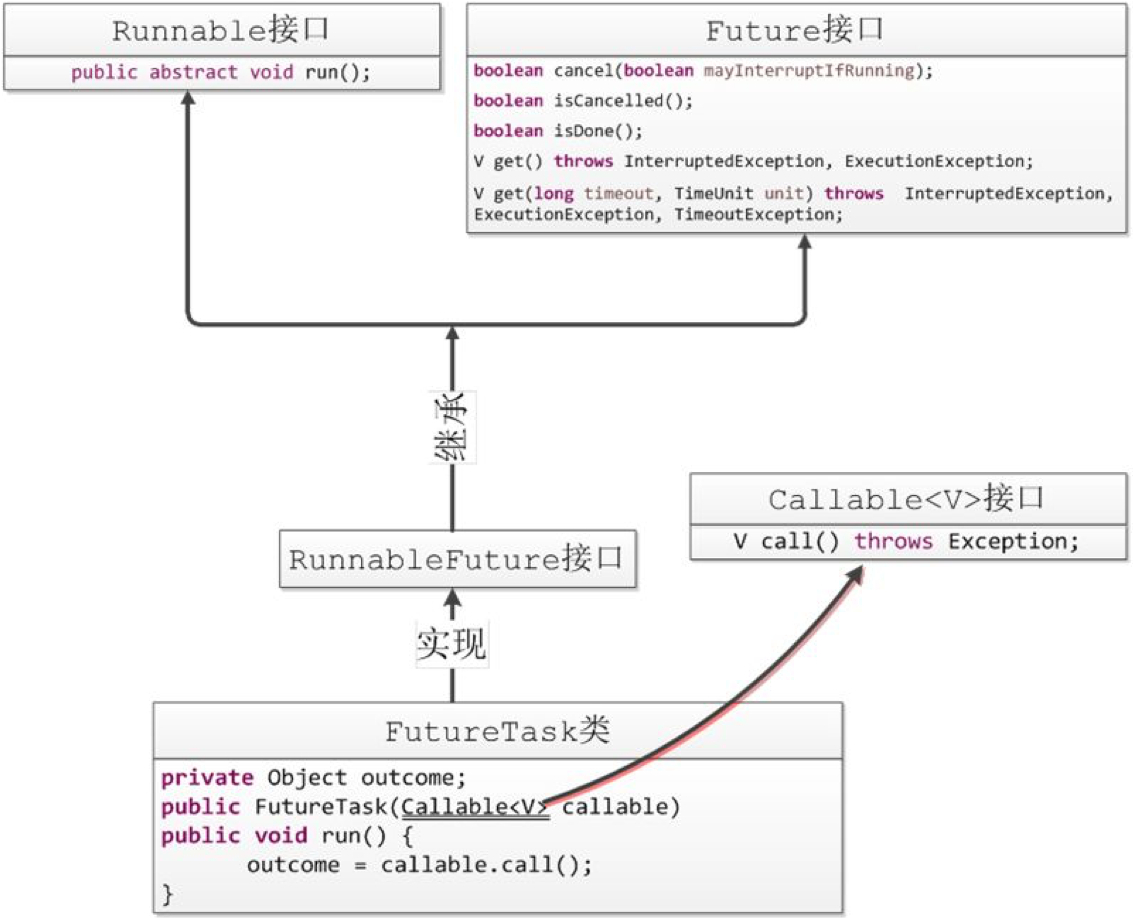Java并发编程系列-(2) 线程的并发工具类

目前已经更新完《Java并发编程》,《Docker教程》和《JVM性能优化》,欢迎关注【后端精进之路】,轻松阅读全部文章。
Java并发编程:
- Java并发编程系列-(1) 并发编程基础
- Java并发编程系列-(2) 线程的并发工具类
- Java并发编程系列-(3) 原子操作与CAS
- Java并发编程系列-(4) 显式锁与AQS
- Java并发编程系列-(5) Java并发容器
- Java并发编程系列-(6) Java线程池
- Java并发编程系列-(7) Java线程安全
- Java并发编程系列-(8) JMM和底层实现原理
- Java并发编程系列-(9) JDK 8/9/10中的并发
Docker教程:
JVM性能优化:
2.线程的并发工具类
2.1 Fork-Join
JDK 7中引入了fork-join框架,专门来解决计算密集型的任务。可以将一个大任务,拆分成若干个小任务,如下图所示:

Fork-Join框架利用了分而治之的思想:什么是分而治之?规模为N的问题,N<阈值,直接解决,N>阈值,将N分解为K个小规模子问题,子问题互相对立,与原问题形式相同,将子问题的解合并得到原问题的解.
具体使用中,需要向ForkJoinPool线程池提交一个ForkJoinTask任务。ForkJoinTask任务有两个重要的子类,RecursiveAction类和RecursiveTask类,他们分别表示没有返回值的任务和可以有返回值的任务。
RecursiveAction类
下面的例子中,我们使用RecursiveAction遍历指定目录来寻找特定类型文件,需要实现compute方法。
public class FindDirsFiles extends RecursiveAction{
private File path;//当前任务需要搜寻的目录
public FindDirsFiles(File path) {
this.path = path;
}
public static void main(String [] args){
try {
// 用一个 ForkJoinPool 实例调度总任务
ForkJoinPool pool = new ForkJoinPool();
FindDirsFiles task = new FindDirsFiles(new File("F:/"));
pool.execute(task);//异步调用
System.out.println("Task is Running......");
Thread.sleep(1);
int otherWork = 0;
for(int i=0;i<100;i++){
otherWork = otherWork+i;
}
System.out.println("Main Thread done sth......,otherWork="+otherWork);
task.join();//阻塞的方法
System.out.println("Task end");
} catch (Exception e) {
e.printStackTrace();
}
}
@Override
protected void compute() {
List<FindDirsFiles> subTasks = new ArrayList<>();
File[] files = path.listFiles();
if(files!=null) {
for(File file:files) {
if(file.isDirectory()) {
subTasks.add(new FindDirsFiles(file));
}else {
//遇到文件,检查
if(file.getAbsolutePath().endsWith("txt")) {
System.out.println("文件:"+file.getAbsolutePath());
}
}
}
if(!subTasks.isEmpty()) {
for(FindDirsFiles subTask:invokeAll(subTasks)) {
subTask.join();//等待子任务执行完成
}
}
}
}
}
RecursiveTask类
下面的例子中,利用RecursiveTask来实现数值累加。
public class SumArray {
private static class SumTask extends RecursiveTask<Integer>{
private final static int THRESHOLD = MakeArray.ARRAY_LENGTH/10;
private int[] src; //表示我们要实际统计的数组
private int fromIndex;//开始统计的下标
private int toIndex;//统计到哪里结束的下标
public SumTask(int[] src, int fromIndex, int toIndex) {
this.src = src;
this.fromIndex = fromIndex;
this.toIndex = toIndex;
}
@Override
protected Integer compute() {
if(toIndex-fromIndex < THRESHOLD) {
int count = 0;
for(int i=fromIndex;i<=toIndex;i++) {
//SleepTools.ms(1);
count = count + src[i];
}
return count;
}else {
//fromIndex....mid....toIndex
//1...................70....100
int mid = (fromIndex+toIndex)/2;
SumTask left = new SumTask(src,fromIndex,mid);
SumTask right = new SumTask(src,mid+1,toIndex);
invokeAll(left,right);
// left.fork();
// right.fork();
return left.join()+right.join();
}
}
}
public static void main(String[] args) {
ForkJoinPool pool = new ForkJoinPool();
int[] src = MakeArray.makeArray();
SumTask innerFind = new SumTask(src,0,src.length-1);
long start = System.currentTimeMillis();
pool.invoke(innerFind);//同步调用
System.out.println("Task is Running.....");
System.out.println("The count is "+innerFind.join()
+" spend time:"+(System.currentTimeMillis()-start)+"ms");
}
}
注意到fork和invokeAll都能达到相同的效果,只是fork将task交给工作线程后立刻返回;但是invokeAll会fork其中一个任务后,同时同步的调用另外一个任务,然后等待两个任务完成,可以参考invokeAll的实现:
ublic static void invokeAll(ForkJoinTask<?> t1, ForkJoinTask<?> t2) {
int s1, s2;
t2.fork();
if (((s1 = t1.doInvoke()) & ABNORMAL) != 0)
t1.reportException(s1);
if (((s2 = t2.doJoin()) & ABNORMAL) != 0)
t2.reportException(s2);
}
工作密取(Work Stealing)
在后台,fork-join框架使用了一种有效的方法来平衡可用线程的负载,称为工作密取(Work stealing)。每个工作线程都有一个双端队列(deque)来完成任务,一个工作线程将子任务压入其双端队列的队头。当一个工作线程空闲时,它会从另一个双端队列的队尾密取一个任务。
ForkJoinPool内部利用循环数组实现了一个双端队列,称为WorkQueue。对于这个Queue,有3种操作方法,分别是push、pop和poll。对于push和pop操作,只能被拥有该Queue的线程所调用。poll操作被用于其他工作线程从该Queue中获得task。
考虑到多线程steal work的情况,当进行poll操作时,会通过CAS操作来保证多线程下的安全性。如果CAS操作成功,则说明窃取成功。

更多细节可以查看ForkJoinPool的实现以及论文https://www.dre.vanderbilt.edu/~schmidt/PDF/work-stealing-dequeue.pdf。
invoke && execute && submit 区别
invoke是同步调用,它会马上执行执行,并且将task join到当前线程,也就是阻塞当前线程。
/**
* Performs the given task, returning its result upon completion.
* If the computation encounters an unchecked Exception or Error,
* it is rethrown as the outcome of this invocation. Rethrown
* exceptions behave in the same way as regular exceptions, but,
* when possible, contain stack traces (as displayed for example
* using {@code ex.printStackTrace()}) of both the current thread
* as well as the thread actually encountering the exception;
* minimally only the latter.
*
* @param task the task
* @param <T> the type of the task's result
* @return the task's result
* @throws NullPointerException if the task is null
* @throws RejectedExecutionException if the task cannot be
* scheduled for execution
*/
public <T> T invoke(ForkJoinTask<T> task) {
if (task == null)
throw new NullPointerException();
externalSubmit(task);
return task.join();
}
execute和submit是异步调用,它会将Task送到Work Queue中等待运行。如果需要看到运行结果,可以在execute和submit后调用join方法。两者的区别只是submit会返回task,execute返回空值。
/**
* Submits a ForkJoinTask for execution.
*
* @param task the task to submit
* @param <T> the type of the task's result
* @return the task
* @throws NullPointerException if the task is null
* @throws RejectedExecutionException if the task cannot be
* scheduled for execution
*/
public <T> ForkJoinTask<T> submit(ForkJoinTask<T> task) {
return externalSubmit(task);
}
下面是execute的实现:
/**
* Arranges for (asynchronous) execution of the given task.
*
* @param task the task
* @throws NullPointerException if the task is null
* @throws RejectedExecutionException if the task cannot be
* scheduled for execution
*/
public void execute(ForkJoinTask<?> task) {
externalSubmit(task);
}
2.2 CountDownLatch
Latch是门栓的意思,顾名思义,CountDownLatch是一个多线程的控制工具类。通常用于让一组线程等待直到倒计时结束,再开始执行。

CountDownLatch的用法如下,
- 初始化count down的次数;
- 在初始化线程中调用countDown对计数器进行减1;
- 工作线程中调用await进行等待,当计时器为0时,工作线程开始工作。
public class UseCountDownLatch {
static CountDownLatch latch = new CountDownLatch(6);
// 初始化线程(只有一步,有4个)
private static class InitThread implements Runnable{
@Override
public void run() {
System.out.println("Thread_"+Thread.currentThread().getId() +" finish init work......");
latch.countDown();//初始化线程完成工作了,countDown方法只扣减一次;
// We can add some tasks after the countDown is invoked
for(int i =0;i<2;i++) {
System.out.println("Thread_"+Thread.currentThread().getId() +" ........continue do its work");
}
}
}
// 业务线程
private static class BusinessThread implements Runnable{
@Override
public void run() {
try {
latch.await();
} catch (InterruptedException e) {
e.printStackTrace();
}
for(int i =0;i<3;i++) {
System.out.println("BusinessThread_"+Thread.currentThread().getId() +" start to do business-----");
}
}
}
public static void main(String[] args) throws InterruptedException {
// 单独的初始化线程,初始化分为2步,需要扣减两次
new Thread(new Runnable() {
@Override
public void run() {
SleepTools.ms(1);
System.out.println("Thread_"+Thread.currentThread().getId() +" finish init work step 1st......");
latch.countDown();//每完成一步初始化工作,扣减一次
System.out.println("begin step 2nd.......");
SleepTools.ms(1);
System.out.println("Thread_"+Thread.currentThread().getId() +" finish init work step 2nd......");
latch.countDown();//每完成一步初始化工作,扣减一次
}
}).start();
new Thread(new BusinessThread()).start();
// Start 3 new init thread
for(int i=0;i<=3;i++){
Thread thread = new Thread(new InitThread());
thread.start();
}
latch.await();
System.out.println("Main do ites work........");
}
}
2.3 CyclicBarrier
CyclicBarrier类实现了一个集结点,称为屏障(barrier)。当一个线程完成了那部分任务之后,它运行到屏障处,一旦所有线程都到达了这个屏障,屏障就撤销,线程就可以继续运行了。

CyclicBarrier的用法如下:
- 构造一个Barrier,需要给出参与的线程数。JDK里提供了两个构造函数,barrierAction为屏障打开之后需要执行的action。
CyclicBarrier(int parties)
CyclicBarrier(int parties, Runnable barrierAction)
- 每个线程做一些事情,完成后在屏障上调用await等待,
public void run() {
doSomeWork();
barrier.await();
...
}
- 当所有线程都到达了await后,此时屏障打开。如果有定义屏障打开后执行的action,则会先执行action。然后其他线程继续往下执行await后面的部分。
下面是具体的例子:
在打开屏障后,输出了各个线程的id。
public class UseCyclicBarrier {
private static CyclicBarrier barrier = new CyclicBarrier(5,new TaskAfterBarrierIsOpenThread());
private static ConcurrentHashMap<String,Long> resultMap = new ConcurrentHashMap<>();//存放子线程工作结果的容器
public static void main(String[] args) {
for(int i=0;i< 5;i++){
Thread thread = new Thread(new SubThread());
thread.start();
}
}
//负责屏障开放以后的工作
private static class TaskAfterBarrierIsOpenThread implements Runnable{
@Override
public void run() {
StringBuilder result = new StringBuilder();
for(Map.Entry<String,Long> workResult:resultMap.entrySet()){
result.append("["+workResult.getValue()+"]");
}
System.out.println(" the result = "+ result);
System.out.println("do other business........");
}
}
//工作线程
private static class SubThread implements Runnable{
@Override
public void run() {
long id = Thread.currentThread().getId();//线程本身的处理结果
resultMap.put(Thread.currentThread().getId()+"",id);
Random r = new Random();//随机决定工作线程的是否睡眠
try {
if(r.nextBoolean()) {
Thread.sleep(2000+id);
System.out.println("Thread_"+id+" ....do something ");
}
System.out.println(id+"....is await");
barrier.await();
Thread.sleep(1000+id);
System.out.println("Thread_"+id+" ....do its business ");
} catch (Exception e) {
e.printStackTrace();
}
}
}
}
注意屏障是可以重复使用的,当所有等待线程被释放后可以被重用。
CountDownLatch和CyclicBarrier对比
countdownlatch的放行由第三者控制,CyclicBarrier放行由一组线程本身控制
countdownlatch放行条件 >= 线程数,CyclicBarrier放行条件 = 线程数
2.4 Semaphore
Semaphore也叫信号量,在JDK1.5被引入,可以用来控制同时访问特定资源的线程数量,通过协调各个线程,以保证合理的使用资源。
Semaphore内部维护了一组虚拟的许可,许可的数量可以通过构造函数的参数指定。
- 访问特定资源前,必须使用acquire方法获得许可,如果许可数量为0,该线程则一直阻塞,直到有可用许可。
- 访问资源后,使用release释放许可。
示例程序如下:
public class MySemaphoreTest {
static Semaphore semaphore = new Semaphore(4);
private static class BusinessThread extends Thread {
String name = "";
BusinessThread(String name) {
this.name = name;
}
@Override
public void run() {
try {
System.out.println(name + " try to acquire lock...");
System.out.println(name + " : available Semaphore permits now: " + semaphore.availablePermits());
semaphore.acquire();
System.out.println(name + " : got the permit!");
// Do some business work
Thread.sleep(1000);
System.out.println(name + " : release lock...");
semaphore.release();
} catch (Exception e) {
e.printStackTrace();
}
}
}
public static void main(String[] args) {
for (int i = 0; i < 6; i++) {
new BusinessThread((i+1) + "").start();
}
}
}
2.5 Exchanger
当两个线程在同一个数据缓冲区的两个实例上工作时,就可以使用Exchanger。典型的情况是,一个线程向缓冲区填入数据,另一个线程消耗这些数据。当他们都完成之后,相互交换缓冲区。
下面的例子中,在两个线程中分别填入数据,然后交换数据,最后打印从对方线程交换得来的数据。
public class UseExchange {
private static final Exchanger<Set<String>> exchange
= new Exchanger<Set<String>>();
public static void main(String[] args) {
//第一个线程
new Thread(new Runnable() {
@Override
public void run() {
Set<String> setA = new HashSet<String>();//存放数据的容器
try {
setA.add("1");
System.out.println(Thread.currentThread().getName() + " Add 1 to the set");
setA.add("2");
System.out.println(Thread.currentThread().getName() + " Add 2 to the set");
setA.add("3");
System.out.println(Thread.currentThread().getName() + " Add 3 to the set");
setA = exchange.exchange(setA);//交换setA出去,返回交换来的数据setB
/*处理交换后的数据*/
System.out.println(Thread.currentThread().getName() + " print the data after exchange ");
setA.forEach(string -> System.out.println(Thread.currentThread().getName() + " print" + string));
} catch (InterruptedException e) {
}
}
}).start();
//第二个线程
new Thread(new Runnable() {
@Override
public void run() {
Set<String> setB = new HashSet<String>();//存放数据的容器
try {
setB.add("A");
System.out.println(Thread.currentThread().getName() + " Add A to the set");
setB.add("B");
System.out.println(Thread.currentThread().getName() + " Add B to the set");
setB.add("C");
System.out.println(Thread.currentThread().getName() + " Add C to the set");
setB = exchange.exchange(setB);//交换setB出去,返回交换来的数据setA
/*处理交换后的数据*/
System.out.println(Thread.currentThread().getName() + " print the data after exchange ");
setB.forEach(string -> System.out.println(Thread.currentThread().getName() + " print" + string));
} catch (InterruptedException e) {
}
}
}).start();
}
}
2.6 Future、Callable和FutureTask
Future是多线程开发中的一种常见设计模式,核心思想是异步调用。当需要调用一个函数方法时,如果这个函数很慢,需要进行等待,这时可以先处理一些其他任务,在真正需要数据的时候再去尝试获得需要的数据。

以上是Future的基本结构,RunnableFuture继承了Future和Runnable接口,FutureTask可以接收一个Callable实例作为运行的任务。
Future的使用比较简单,例子如下:
public class UseFuture {
/*实现Callable接口,允许有返回值*/
private static class UseCallable implements Callable<Integer>{
private int sum;
@Override
public Integer call() throws Exception {
System.out.println("Callable子线程开始计算");
Thread.sleep(2000);
for(int i=0;i<5000;i++) {
sum = sum+i;
}
System.out.println("Callable子线程计算完成,结果="+sum);
return sum;
}
}
public static void main(String[] args)
throws InterruptedException, ExecutionException {
UseCallable useCallable = new UseCallable();
FutureTask<Integer> futureTask = new FutureTask<Integer>(useCallable);
new Thread(futureTask).start();
Random r = new Random();
SleepTools.second(1);
if(r.nextBoolean()) {//随机决定是获得结果还是终止任务
System.out.println("Get UseCallable result = "+futureTask.get());
}else {
System.out.println("中断计算");
futureTask.cancel(true);
}
}
}
注意Future接口中声明了5个方法,分别为:
- cancel方法:用来取消任务,如果取消任务成功则返回true,如果取消任务失败则返回false。参数mayInterruptIfRunning表示是否允许取消正在执行却没有执行完毕的任务,如果设置true,则表示可以取消正在执行过程中的任务。如果任务已经完成,则无论mayInterruptIfRunning为true还是false,此方法肯定返回false,即如果取消已经完成的任务会返回false;如果任务正在执行,若mayInterruptIfRunning设置为true,则返回true,若mayInterruptIfRunning设置为false,则返回false;如果任务还没有执行,则无论mayInterruptIfRunning为true还是false,肯定返回true。
- isCancelled方法:表示任务是否被取消成功,如果在任务正常完成前被取消成功,则返回 true。
- isDone方法:表示任务是否已经完成,若任务完成,则返回true;
- get()方法:用来获取执行结果,这个方法会产生阻塞,会一直等到任务执行完毕才返回;
- get(long timeout, TimeUnit unit):用来获取执行结果,如果在指定时间内,还没获取到结果,就直接返回null。
本文由『后端精进之路』原创,首发于博客 http://teckee.github.io/ , 转载请注明出处
搜索『后端精进之路』关注公众号,立刻获取最新文章和价值2000元的BATJ精品面试课程。








【推荐】国内首个AI IDE,深度理解中文开发场景,立即下载体验Trae
【推荐】编程新体验,更懂你的AI,立即体验豆包MarsCode编程助手
【推荐】抖音旗下AI助手豆包,你的智能百科全书,全免费不限次数
【推荐】轻量又高性能的 SSH 工具 IShell:AI 加持,快人一步
· SQL Server 2025 AI相关能力初探
· Linux系列:如何用 C#调用 C方法造成内存泄露
· AI与.NET技术实操系列(二):开始使用ML.NET
· 记一次.NET内存居高不下排查解决与启示
· 探究高空视频全景AR技术的实现原理
· 阿里最新开源QwQ-32B,效果媲美deepseek-r1满血版,部署成本又又又降低了!
· SQL Server 2025 AI相关能力初探
· AI编程工具终极对决:字节Trae VS Cursor,谁才是开发者新宠?
· 开源Multi-agent AI智能体框架aevatar.ai,欢迎大家贡献代码
· Manus重磅发布:全球首款通用AI代理技术深度解析与实战指南